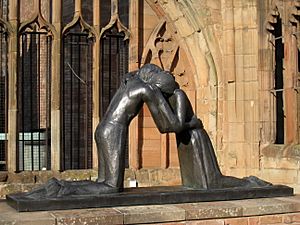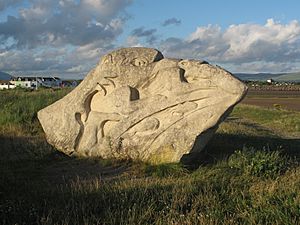Josefina de Vasconcellos facts for kids
Quick facts for kids
Josefina Alys Hermes de Vasconcellos
|
|
|---|---|
| Born | 26 October 1904 Molesey, Surrey, England
|
| Died | 20 July 2005 (aged 100) Blackpool, England
|
| Education |
|
| Known for | Sculpture |
| Spouse(s) | Delmar Banner, m.1930–1983, his death |
Josefina Alys Hermes de Vasconcellos (born October 26, 1904 – died July 20, 2005) was a famous English sculptor. She created beautiful artworks using materials like bronze, stone, wood, and even clear plastic (perspex). For a time, she was the oldest living sculptor in the world! She spent most of her life working in Cumbria, a lovely area in England. Some of her most well-known sculptures include Reconciliation (found at Coventry Cathedral and the University of Bradford), Holy Family (at Liverpool Cathedral and Gloucester Cathedral), Mary and Child (at St. Paul's Cathedral), and a special Nativity scene displayed every Christmas at St. Martin-in-the-Fields in Trafalgar Square.
Contents
Early Life and Education
Josefina de Vasconcellos was born in Molesey, Surrey, England. She was the only child of Hippolyto de Vasconcellos, who was a diplomat from Brazil, and Freda Coleman, an English Quaker.
Josefina started her art journey with drawing lessons at Bournemouth Art School. Later, she studied at the Regent Street Polytechnic in London. In 1923, she won a Bronze Medal for her sculpture design.
Studying Art in Europe
After her success in London, Josefina traveled to Florence, Italy, to study under famous sculptors Guido Calore and Libero Andreotti. She then moved to Paris, France, and joined the Académie de la Grande Chaumière. There, she was taught by Antoine Bourdelle, who had been an assistant to the very famous sculptor Auguste Rodin.
Josefina first showed her work at the Royal Academy Summer Show in 1926. Her piece was called The Repentance of St Hubert. In 1929, she finished her first big project for a church in Varengeville-sur-Mer, Normandy. This work included a life-sized statue of Saint Valéry lying under a stone altar. When she returned to England, Josefina continued her studies at the Royal Academy Schools. In 1930, she came in second place in the important Prix de Rome art competition.
Sculpting Career and Famous Works
During the Second World War, Josefina de Vasconcellos began working on several large sculptures. One of these was The Last Chimera, which can now be seen in the grounds of the Canongate Kirk in Edinburgh. Another important work was The Hand, a memorial made of green slate. It honored a friend who died in the war and now serves as a war memorial at St Bees School in Cumbria.
Post-War Art and Recognition
After the war, Josefina and her husband, Delmar Banner, opened a studio in London. They also kept their home in the beautiful Lake District. In December 1946, they held a joint art show. Some of Josefina's larger sculptures, like The Last Chimera, were even displayed on a bombsite in Piccadilly! This exhibition helped Josefina become well-known in the British art world.
She regularly showed her sculptures at the Royal Academy and the Paris Salon. In 1948, she made history by becoming the first female member of the Royal British Society of Sculptors. She also helped start the Society of Portrait Sculptors in 1953.
Notable Sculptures and Portraits
Josefina created many portrait busts and sculptures of famous people. These included Lord Denning, writer Edith Sitwell, athlete Roger Bannister, and journalist James Cameron. She even sculpted Tenzing Norgay (one of the first climbers to reach the top of Mount Everest) using clear plastic (perspex).
Other important projects included the Prince of Peace (1950), a war memorial in Aldershot. In 1955, with help from students, she created Mary and Child, which is still in the crypt of St. Paul's Cathedral. In 1959, she was asked to create a Nativity scene with life-sized figures for St. Martin-in-the-Fields in Trafalgar Square. This beautiful scene is still a regular part of the church's Christmas display. In the 1990s, she designed a memorial for pilots who were based near her Lake District home during World War Two.
The Reconciliation Sculpture
In 1977, the peace studies department at Bradford University asked Josefina to create a sculpture. She called it Reunion. After it was repaired in 1994, it was renamed Reconciliation.
In 1995, to mark 50 years since the end of World War II, bronze copies of this sculpture were placed in important locations. One is in the ruins of Coventry Cathedral in England, and another is in the Hiroshima Peace Park in Japan. A third copy is in the grounds of Stormont in Belfast, Northern Ireland. In 1999, to celebrate the opening of the rebuilt German Reichstag building, another copy was placed as part of the Berlin Wall memorial.
Josefina's Artistic Style
Throughout her life, Josefina de Vasconcellos took on many large sculpture projects. Her style was often flowing and natural, showing figures in a realistic way. This was different from the more abstract styles of other famous sculptors like Henry Moore and Barbara Hepworth. Many of Josefina's sculptures had religious themes. You can find her work in churches and cathedrals across Britain, including those in Blackburn, Bristol, Carlisle, Gloucester, Liverpool, Norwich, and Wells. Her art is also held in galleries like the National Art Gallery in Rio de Janeiro and the Sheffield Art Galleries.
Personal Life and Charity Work
In 1930, Josefina married artist and teacher Delmar Banner. He was a lay preacher in the Church of England. They stayed together until his death in 1983. Delmar's faith led Josefina to join the Church of England, and her beliefs became a big part of her artistic work.
The couple adopted two boys in 1940. The family settled in a farmhouse called The Bield in Little Langdale in the Lake District. Josefina set up her art studio in an outbuilding there. Josefina and her husband were also godparents to at least 20 children!
Helping Disadvantaged Children
Josefina was very involved in helping others. In 1967, she helped create the Beckstone Centre. This was a special place for disadvantaged boys, similar to an Outward Bound facility, located at Beckstones in the Duddon Valley.
In 1975, she started The Harriet Trust on the Duddon Estuary at Millom. This trust helped disabled children enjoy nature holidays in a specially built home. They even used a modified fishing trawler called The Harriet as a fun recreation space. It was this important charity work, even more than her sculptures, that led to Josefina de Vasconcellos being awarded the Order of the British Empire in 1985. This award is a special honor given by the British monarch for great achievements.
Later Years and Legacy
In 1988, due to illness, Josefina had to leave Little Langdale. For a while, she stayed at Isel Hall near Cockermouth. She later found a small cottage and studio at Peggy Hill, Ambleside. She continued to create art well into her 90s. Her very last piece, Escape to Light, was made in 2001. It honors the brave men of the Independent Off-Shore Rescue Service and is located at Haverigg on the Cumbrian coast.
Josefina de Vasconcellos passed away on July 20, 2005, at 6 am, at the Orchard Lodge nursing home in Blackpool. She was 100 years old, having celebrated her birthday just a few months before. In her 99th year, she published a book called 'She was Loved: Memories of Beatrix Potter'. This book shared letters and stories about her long friendship with the famous author Beatrix Potter. It also included photos of her sculptures and other pictures.
|
See also
 In Spanish: Josefina de Vasconcellos para niños
In Spanish: Josefina de Vasconcellos para niños



